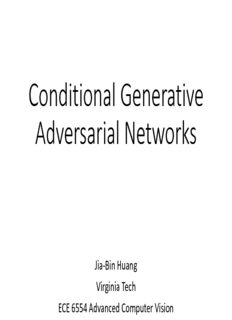
Conditional Generative Adversarial Networks PDF
Preview Conditional Generative Adversarial Networks
Conditional Generative Adversarial Networks Jia-Bin Huang Virginia Tech ECE 6554 Advanced Computer Vision Today’s class • Discussions • Review basic ideas of GAN • Examples of conditional GAN • Experiment presentation by Sanket Why Generative Models? • Excellent test of our ability to use high- dimensional, complicated probability distributions • Simulate possible futures for planning or simulated RL • Missing data • Semi-supervised learning • Multi-modal outputs • Realistic generation tasks (Goodfellow 2016) Generative Modeling • Density estimation • Sample generation Adversarial Nets Framework Training Procedure • Use SGD-like algorithm of choice (Adam) on two minibatches simultaneously: • A minibatch of training examples • A minibatch of generated samples • Optional: run k steps of one player for every step of the other player. (Goodfellow 2016) Minimax Game • Equilibrium is a saddle point of the discriminator loss • Resembles Jensen-Shannon divergence • Generator minimizes the log-probability of the discriminator being correct (Goodfellow 2016) Discriminator Strategy • Optimal discrimator Non-Saturating Game • Equilibrium no longer describable with a single loss • Generator maximizes the log-probability of the discriminator being mistaken • Heuristically motivated; generator can still learn even when discriminator successfully rejects all generator samples (Goodfellow 2016) Review: GAN • GANs are generative models that use supervised learning to approximate an intractable cost function • GANs can simulate many cost functions, including the one used for maximum likelihood • Finding Nash equilibria in high-dimensional, continuous, nonconvex games is an important open research problem
Description: